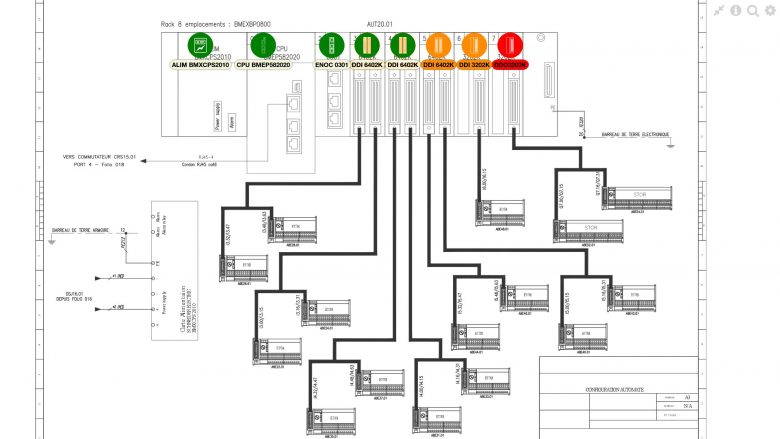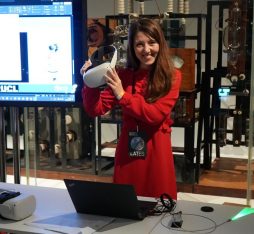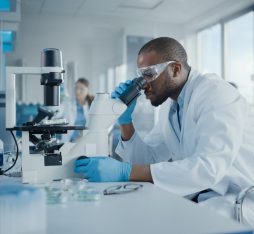
Thing’in the future is a graph-based platform that links together digital twins of simple to more complex physical objects such as industrial equipment, sensors, factories, production plants, boxes, tools, buildings, suppliers, subcontractors… that are, indeed, the sub-components of a real industrial environment. By that way, a knowledge graph has been created where the digital twins and their relations handle data coming from multiple sources. Developers can easily access the registered data through Thing’in API, leverage the knowledge to create new business applications or to improve the manufacturing process (efficiency and quality).
How does this digital twin graph help the worker to assemble an industrial object?
Over the past years, Thing’in the future has been focusing on the simple but nevertheless standardized modeling of connected or unconnected objects and the relationships between them considering the context in which they are located. Graphs are a natural representation of systems and complex ecosystems with their relationships and their evolution in time.
Thing’in the future helps the worker to assemble an industrial object, performs quality controls and improves the manufacturing process
Let’s take the example of an industrial fabrication of electrical panels, represented by series of industrial automation and supervision units. Each physical part is modelized using a semantical definition brought by ontologies (i.e.: smart industry ontologies, smart building ontologies, etc.). The digital twin of the electric panel is composed of many digital twins linked together in the graph. The left part of the figure 1 below illustrates the physical electric panel partially assembled and four geolocated boxes where some parts are located. The right part of the figure is a graph representation of the digital twin created in Thing’in. The color of the lamp varies depending on the presence of all the required parts in the assembly area.

Figure 1: Digital twin of the industrial panel in Thing’in the future
When the first phase of the assembly process is completed, some digital twins represented in the right part of the figure above are already plugged on a rack called “BMEXBP0800”, highlighted on Figure1. The status of the digital twins associated to the communication module called “ENOC”, the power supply “ALIM” and the processor module “CPU” in green color, are “installed”. The red node linked to rack means that this part of the rack is not available in the assembly zone. Thanks to the indoor geolocation system, it has been detected in box1 in the components storage zone. The relations between the highlighted rack and those different parts indicate that all of them must be on the rack but some of them in orange or red colors are not yet inserted and not located in the same area (or zone) of the production plant.
In the following, we show a technical graph view of the digital twins that simply represents an assembly diagram of the electrical panels. This graph offers a very detailed view that helps an operator to correctly plug each component at the right place.

Figure 2: Assembly diagram provided by the digital twin platform
The panel was therefore partially equipped, then sent to the warehouse until the necessary parts to complete the second and final phases are in stock.
The assembly diagram as well as the graph view displays the digital twin of the Electric panel and its subparts. The synchronization between the physical environment and its virtual representation is ensured by the geolocation system, smart tracking and Thing’in that maintains the digital twin up to date according to the events received from smart tracking. The mechanism is detailed below.
As soon as the necessary components are available in the production plant, a notification is sent to the assembly process manager who reschedules the assembly of the electric panel on the production line.
Rolling back to the operator, the parts he/she must assemble are distributed in three containers (boxes). However, one of the containers is missing which explains the red color of the digital twin located in this container. Therefore, the operation is not authorized to start.
The operator uses the smart tracking application on his/her mobile phone to scan the reference of the missing component from Thing’in platform. An accurate indoor geolocation system, based on Quuppa antennas has been deployed in the factory to track the containers and easily locate the missing parts. As the parts are not connected, some ELA beacons have been stuck on each container to make them connected and trackable. With smart tracking, the operator can locate the missing part in the storage area and transfer it in the assembly area. As soon as the position of the beacon changes, the system computes the new position. The geofencing mechanism embedded in smart tracking can notify the digital twin platform in real time in case the boxes enter or leave a geographical area/zone on the production plant. The assembly diagram is updated by the digital twin and the operator can see in real time the color changing on his schema.
Once all the components are available in the assembly zone, the digital twin status of the “missing” component changes to “available for installation”. The final production phase can resume allowing the operator to assemble everything.
Once the electrical panel is fully equipped, the operator can confirm the termination of the assembly process.
The digital twin improves the operator efficiency. It brings relevant information to help him/her to quickly locate all the required materials to build the industrial equipment and avoid losing time looking for the parts.
How does this digital twin graph help to improve the manufacturing process?
A digital twin of the entire product manufacturing process (from the very first assembly phase to the end), can be viewed in Thing’in Platform including complete details of the product and parts locations, actions, dates and duration.
A quality check is performed at the digital twin level to ensure that all the required parts have been assembled in the industrial equipment and all the history is analyzed.

Figure 3: quality control and data analysis of the whole process
The figure above is a graphical timeline representation of the entire manufacturing process.
As far as all the events that happen during the production process are saved in the heart of Thing’in the future, it’s possible to replay what happened at a specific moment and analyze how to optimize each step duration. Jump in the past with the timeline and explore the state of the equipment at a given moment during its manufacturing. Figure 3 displays an example map of a production plant. This control view allows the production manager to see immediately, the path followed by the electrical panel through each technical areas involved in its production and how long it spent in each area (wiring, assembling, quality control, warehouse and expedition zone). The duration of each operation done by the operator is stored by the digital twin platform.
Conclusion
The digital twin has multiple facets, it can bring a continuous and real-time monitoring tool, it helps to optimize productivity and predict its evolution by analyzing the data collected over time. Real-time synchronization between the digital twin and its dual object is essential. The notion of real-time is adapted to the context and use case, and does not always imply a millisecond synchronization. Here, in the demonstration we showcased, the synchronization delay is about 3 seconds which means that 3 seconds after the position of a beacon has changed, the digital twin is updated and the views accordingly. This time is compatible with this assembly process.
Thing’in the future brings together a structural and semantic modeling of the manufacturing context over time. It includes various production components, tracked in real-time with a dedicated IoT platform, building elements, work orders, suppliers, subcontractors, and all consequent actions. This high-level traceability enables an accurate analysis that detects potential errors, identifies production gaps, evaluates the time spent in each phase.
The insight gained significantly helps taking targeted measures in order to optimize the manufacturing flows. Production becomes more reliable, costs are reduced, and the final products’ quality and delivery time improved.
With Thing’in the future, the challenge is to stimulate industrial renewal by providing manufacturers with solutions to develop new services that will be based on digital twins and network connectivity (5G), which will make it possible to accelerate the digital transformation towards industry 4.0.











